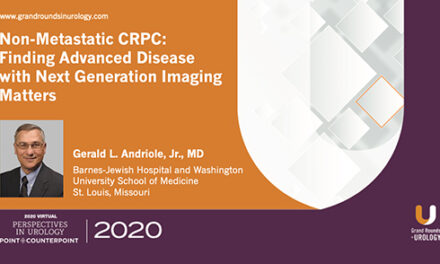Dr. James A. Eastham spoke at the 24th International Prostate Cancer Update on Friday, February 21, 2014 on “Advances in Focal Ablative Treatment of Prostate Cancer.” In his presentation, Dr. Eastham discusses selected patients who will benefit from focal therapy and the challenges of identifying these patients.
Presentation:
Keywords: biopsy, prostate cancer, focal ablative therapy, outcomes [/su_tab]
How to cite: Eastham, James A. “Advances in Focal Ablative Treatment of Prostate Cancer.” Grand Rounds in Urology. January 14, 2015. Accessed Dec 2024. https://dev.grandroundsinurology.com/prostate-cancer-james-a-eastham-focal-ablative-treatment/.
Transcript
Advances in Focal Ablative Treatment of Prostate Cancer
So the theme of this session is advanced cancer but we’re going to take a little respite from that to look at a focal therapy presentation that I’ll give. You can put up my first ARS question of the first of two.
Which of the following statements is true? HIFU has recently been approved by the FDA for prostate cancer focal therapy; simultaneous MRI guided cryotherapy improves continence and potency compared to ultrasound guided cryotherapy; PSA, 50% of treatment is an accepted definition of biochemical failure; all of those are correct; none of them are correct.
Good. So none of them are correct.
And let’s look at the second question, please. Which of the following statements is true? Focal therapy is only indicated in men with NCCN low risk prostate cancer; continence if reported in more than 95% of the men treated with focal therapy; fistula occur in approximately 5% of men after focal therapy: all are correct; none are correct.
Okay. So the correct answer is actually 2. And we’ll go through all of those. If you can pop up my slides please.
We heard a bit about focal therapy this morning and it was a very nice presentation that went through some of the things that I’m going to talk about, but I think all of us in the audience who treat prostate cancer frequently ask, why do you have to take my whole prostate out or why to do you have to radiate the whole prostate, can’t you just treat the cancer? And I think that’s becoming a more and more difficult question to not address and that we’re identifying cancers earlier, many of them are only on one side of the prostate or only on one core, and certainly too many patients and certainly many practitioners whole gland therapy is a bit of an overkill.
So we saw a similar slide to this this morning but basically if you think of prostate cancer, it really, the treatment options are all going to depend on risk. Those patients with low risk disease, we probably can manage them best expectantly active surveillance. Those with intermediate risk disease if they’re isolated to a particular area of the prostate, or probably the best candidates for focal therapy, and then certainly those with diffused or high risk disease are those that require a whole gland treatment.
And certainly focal therapy will become increasingly used in patients with prostate cancer and this is because of stage migration. We’re biopsying people for reasons that are less and less, lower and lower PSAs, we’re taking more and more biopsies and we are finding very small cancers and very isolated areas within the prostate. This is certainly happening in many younger men who have as some of their older counterparts do, a significant interest in their quality of life. And for some patients, it’s an option that is more palatable than active surveillance, the thought of living with an untreated cancer without 100% guarantee that it’s not going to somehow affect their longevity, it’s difficult for many men to accept. And right now the main option is to either go to radiation therapy or radical prostatectomy and focal therapy certainly may play a role in this aspect of the disease.
So focal therapy basically plays into the paradigm of how we treat prostate cancer. And as I mentioned it really is a risk based assessment based on an individual patient’s findings, his PSA, where the biopsies were positive, what they showed, etc.
This is from William Barsell [phonetic]. It’s an older slide now, but shows how the prostate can basically be mapped out. We’ve heard about template biopsies, we’ve heard about MR guided biopsies. But in many ways you can divide the prostate into how many ever quadrants you want. Simply it can be left and right and you use hemigland ablation, or you can be perhaps a little more refined and dice it up a little bit more in term of the number of quadrants you are willing to treat or not treat, and you can map glands and find out where the cancers are and ablate the area of concern.
Now there are a variety of different ablation techniques. The first four of these six are actually FDA approved. So cryotherapy, electroporation of the NanoKnife, brachytherapy or HDR, the interstitial laser, all of those have been approved for the FDA for tissue ablation, not specifically prostate tissue ablation, but tissue ablation in general. So it can be used in focal therapy and you can bill for it. There is a code for it. HIFU and photodynamic therapy are available in some centers as an investigational tool, but have not been FDA approved in the usual setting.
All of these strategies whether they’re heating, cooling, electrocuting, they kill tissue. And there’s very good basic science and human evidence for that. They all result in a black or a dark lesion on the MRI meaning there’s dead tissue and however you look at it, whether it’s cryotherapy, photodynamic therapy or electroporation, you end up with hyalinized scar and the biopsy basically shows dead tissue. And in the area there are very few prostatic glands that are left behind. So I think as a proof of concept, can we destroy prostate cancer tissue focally, all of those technologies have basically shown that based on both MRI imaging and by histopathology.
Now there are not a lot of good long term studies on focal therapy. Most of them are relatively short term and they show that it’s safe and that if you look at PSA it goes down. If you biopsy the area, you treat it, it looks like scar. Whether that will improve survival, reduce the risk of other more invasive therapies, hormonal therapy, etc., we have no clue.
This is a nice review that was recently published in European Urology, from many of the proponents of focal therapy and basically they reviewed the literature and tried to look at what they could glean from the multitude of articles that were out there. They used review statistical things to try to identify the studies that were important.
Of the multitude of studies that they reviewed, I think there were several hundreds of them. They only thought 25 were worthy of reporting on. And that was over 2,000 patients so this isn’t something that’s a novel technique. It has been done on multiple patients. Follow-up ranged from zero to 10 years but in the majority the follow-up was relatively short. The typical prostate cancer population, a little more than half of the patients had low risk disease, but about 20% of the patients had high risk disease. Most of these were from Europe, so they were HIFU based studies, but there were also a significant number of cryotherapy studies and then a smattering of the other technologies, brachytherapy, photodynamic therapy, and laser interstitial ablation.
Now from the preoperative assessment, only 14 of those 25 studies actually reported what they did. And again, most of them were based on TRUS biopsy technology. So TRUS alone, or TRUS with some Doppler features, perhaps combined with MRI, or a template biopsy with MRI which I think is at least today one of the–at least in the United States, most patients who were considered for focal therapy. Most will undergo either an MR guided transrectal biopsy or a template guided biopsy. It will not rely simply on TRUS alone in a standard 12 core biopsy. So there is no standard way pretreatment how these patients are assessed.
Again, the side effect profile appears to be very good. Pad-free rates, that was the answer to one of the ARS questions, 95-100%. The majority of the patients are leak-free. Those who do leak don’t wear a pad. Erectile function based on patient reported outcome s, that’s what PRO stands for are fairly good. It depends on how much ablation you’re doing. The less you ablate, the higher the erectile function rates. There are some patients who develop a stricture, they’re rare. Retention in UTIs in the less than 20% of patients. Fistulae rates are very low, again the less you ablate, the less likely the stricture, but in all of the studies stricture rates were less than 1% so that’s why the 5% answer in that ARS question was incorrect.
If one looks at cancer control, again, a variety of different definitions. Many of the studies just didn’t use biopsies, only nine of the studies of the 25 that were ultimately reviewed actually reported biopsy outcome data. Three only biopsied the treated area. Another six biopsied the whole prostate, and then they characterized the biopsies as having either insignificant disease or clinically significant disease and again you can read the numbers there. At least insignificant disease was in up to 50% of the patients. PSA dropped in most of these. If you use a Phoenix definition of failure which probably is not the correct definition, but many of the studies have adopted that. Remember Phoenix was adopted for whole gland treatment using radiation therapy. It’s not used for hemigland treatment of anything, so using that definition which is nadir plus 2, most of the patients met that definition. And retreatment rates were up to a third of patients. So of these were repeat focal therapy, some of these went on to either surgery or radiation. And in the short follow-up of these studies with at least half of the patient having low risk disease, death and metastasis was incredibly rare. Probably more a function of patient selection than follow-up than actually benefit of the treatment.
In summary, I think that what this review of focal therapy shows is that it is a feasible technology. I don’t think anyone would argue that you can’t put an ultrasound probe in a man’s bottom, but some type of thermal based mechanism into the prostate and ablate tissue. If you do small areas of ablation, the toxicity is relatively a small, some men do have retention after the procedure, but incontinence rates and erectile dysfunction rates are very reasonable especially in comparison to whole gland treatments, which is the excellent functional outcomes. And the article concluded that short term disease control is acceptable or encouraging. That may be a bit of a stretch, but at least you know you can destroy tissue, it’s how we monitor the destruction process I think that we need to get a little bit better on.
The weaknesses are that these are basically single center small studies, very short follow-up, and there’s really no outcomes other than either a biopsy outcome in some of the studies that were done. Certainly no outcomes on metastases or cancer specific survival.
So in summary, technically feasible, whatever ablative strategy you have in your hospital is probably the one you’re going to use. I don’t think we know yet whether cryotherapy is going to be better than electroporation, etc., I think you’ll have your own thoughts on that based on your experience with the ablative tools. I think small areas of ablation have excellent continence and potency rates. Biopsy results, short term are excellent, of the ablated area, how the rest of the prostate behaves is to be determined. And then what happens in those men who fail is really unknown. Are they still candidates for focal therapy? Do we then immediately go to a whole gland treatment strategy? If we do, what strategy is best, should it be radiation, should it be surgery? I think all of those are unknown that awaits future study.
Now the FDA is well aware that focal therapy is increasing in popularity around the country, and they put together a public workshop, it was open to everyone at the AUA this year, and it was really trying to guide industry on how to better design a study that could lead to the device’s approval not just for tissue ablation but specifically for focal therapy in prostate cancer. They understand… the FDA understands that survival is an impractical endpoint. That the industry can’t do 20 year studies with a technology that they can’t make any capital return on.
So what the panel, and they were various panel members in the audience could chime in, but basically there were very few points of consensus which was a bit frustrating to folks who were trying to move this field forward. One point of consensus is that if a patient doesn’t need treatment, focal therapy is probably not the right answer for them. If they’re an active surveillance patient because they are very low risk, they’re not going to benefit from treatment, and basically any treatment is overtreatment, and I think most of us would agree with that. Overall survival as I mentioned is an impractical endpoint as was improvement in symptoms. All of these patients are essentially asymptomatic, so you do anything to them, you’ll either keep them at their baseline or make them worse. You’re not going to make them better and of course, patient reported outcomes are better than physician reported outcomes.
The problem came in, okay, if survival is not a reasonable endpoint, what can we use to get a technology approved, and there was absolutely no consensus. The FDA has reviewed previous trials from the photodynamic group in particular, where they used either a PS endpoint or a biopsy endpoint and they frankly said, those are not acceptable. So that doesn’t leave a lot of leeway in terms of well, what is a viable endpoint. Metastasis free survival, that’s still decades down the road, so there really was no consensus on what an oncologic endpoint could be. In addition there was no consensus on do you need to treat every single focus of cancer, or can you just treat the potentially lethal cancers. So if a man has a Gleason 8 on one side, and a small amount of Gleason 3 on the other side, do both lesions need to be treated or do you accept the Gleason 6 and just treat the Gleason 8? And again unfortunately, none of this led to any consensus. So I think we’re left a bit in the black box of how we’re going to further investigate and evaluate these technologies.
Short term outcomes will be PSA, that’s not an acceptable outcome. Biopsies aren’t acceptable, but we’ll have to see over time what clinical benefit these will be. And as a final aspect of this particular meeting, there wasn’t any acceptance at least in the AUA which was about six months or so ago that MRI can be used either accurately, identify patients or to monitor patients. That you needed to do tissue based assessments rather than simply rely on the MRI to guide therapy even though there are some centers that are ablating MRI detected lesions without histologic confirmation believe it or not. And I believe that’s my…
So as a finally summary, I think most people would agree that there are selected patients who will benefit from focal therapy. How to identify these patients is a bit of the unknown. I think it’s a reasonable thought process to think that focal treatments will be useful in our treatment of men with prostate cancer. There are a number of ablative tools; no one has been shown superior to the other. I’m not sure if we’ll ever have head-to-head studies, but it’s probably the one you already have at your center as the one you’re going to use. And unfortunately, there is no consensus on what success means, and we’ll be left with the technologies we have today rather than HIFU for example getting approved or photodynamic therapy getting approved for focal ablation in prostate cancer. Thank you very much.
References
Valerio M, Ahmed HU, Emberton M, et al. The role of focal therapy in the management of localised prostate cancer: a systematic review.
Eur Urol. 2014 Oct;66(4):732-51. .http://www.ncbi.nlm.nih.gov/pubmed/23769825
Q&A
1. Which of the following statements is true – HIFU has recently been approved by the FDA for prostate cancer focal therapy; simultaneous MRI guided cryotherapy improves continence and potency compared to ultrasound guided cryotherapy; PSA, 50% of treatment is an accepted definition of biochemical failure; all of those are correct; or none of them are correct?
The correct answer is none of them are correct.
2. Which of the following statements is true – Focal therapy is only indicated in men with NCCN low risk prostate cancer; continence if reported in more than 95% of the men treated with focal therapy; fistula occur in approximately 5% of men after focal therapy: all are correct; none are correct?
The correct answer is 2, continence if reported in more than 95% of the men treated with focal therapy.
ABOUT THE AUTHOR
James A. Eastham, MD, FACS, is the Peter T. Scardino Chair in Oncology and Chief of the Urology Service in the Department of Surgery at Memorial Sloan-Kettering Cancer Center in New York. Dr. Eastham received his medical degree from the University of Southern California, Los Angeles. He completed an Internship in General Surgery and a Residency in Urology at Los Angeles County+USC Medical Center. He went on to complete a Fellowship in Urologic Oncology at Baylor College of Medicine in Houston, Texas. Prior to his appointment at Memorial Sloan-Kettering Cancer Center, Dr. Eastham was an Assistant and Associate Professor in the Department of Urology at Louisiana State University in Shreveport and Chief of Urology at Overton-Brooks Veterans Administration Medical Center in Louisiana.
Dr. Eastham’s research has focused on the prevention and treatment of prostate cancer, and he has a particular interest in improving oncologic and quality-of-life outcomes after radical prostatectomy. He has authored or co-authored over 300 articles which have appeared in peer-reviewed journals such as the Journal of the American Medical Association, the Journal of Urology, the Journal of Clinical Oncology, Urology, and Transplantation. In addition, he has authored numerous book chapters, reviews, monographs, and abstracts. He is a Fellow of the American College of Surgeons and a member of several professional societies, including the American Urologic Association, the Society of Urologic Oncology, and the Societé Internationale D’Urologie.





